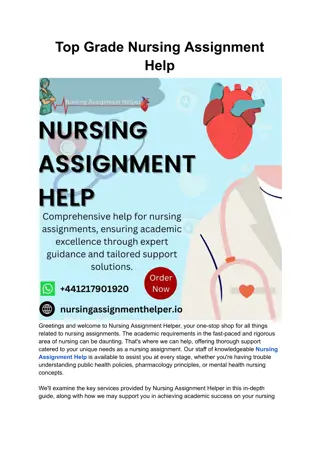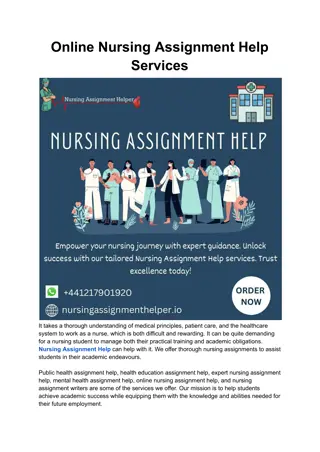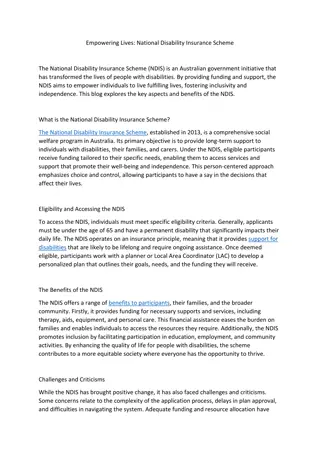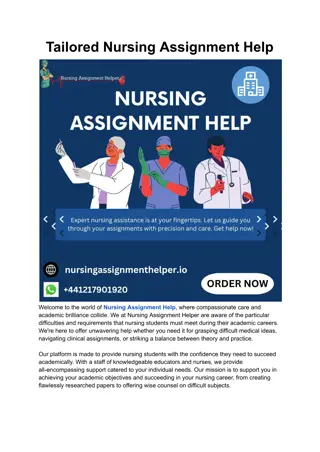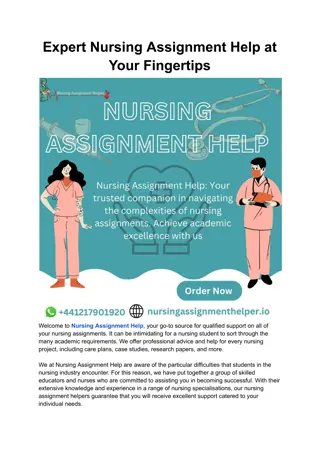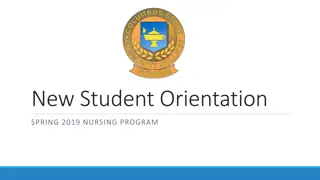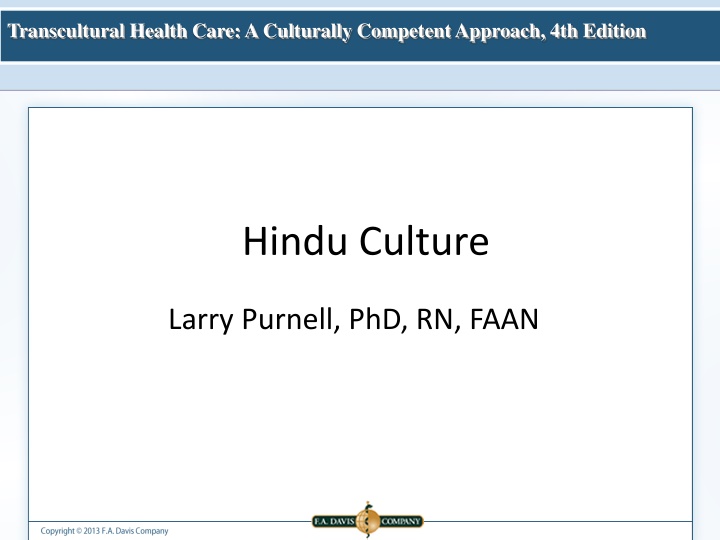
Culturally Competent Approach to Hindu Healthcare
Explore Hindu culture in healthcare with insights into communication, traditions, and beliefs. Learn about the importance of understanding diverse cultural practices for providing effective healthcare services to the Hindu population, particularly in transcultural healthcare settings.
Download Presentation

Please find below an Image/Link to download the presentation.
The content on the website is provided AS IS for your information and personal use only. It may not be sold, licensed, or shared on other websites without obtaining consent from the author. If you encounter any issues during the download, it is possible that the publisher has removed the file from their server.
You are allowed to download the files provided on this website for personal or commercial use, subject to the condition that they are used lawfully. All files are the property of their respective owners.
The content on the website is provided AS IS for your information and personal use only. It may not be sold, licensed, or shared on other websites without obtaining consent from the author.
E N D
Presentation Transcript
Transcultural Health Care: A Culturally Competent Approach, 4th Edition Hindu Culture Larry Purnell, PhD, RN, FAAN
Transcultural Health Care: A Culturally Competent Approach, 4th Edition Hindu Overview/Heritage More than a billion people inhabit India. Eighty percent of the population are Hindus, followers of Hinduism. Other significant religious groups include Sikhs, Moslems, and Christians.
Transcultural Health Care: A Culturally Competent Approach, 4th Edition Hindu Overview/Heritage Different religious sectors share many common cultural beliefs and practices. Immigrants to the United States come predominantly from urban areas, including all major Indian states.
Transcultural Health Care: A Culturally Competent Approach, 4th Edition Hindu Overview/Heritage Most recent immigrants are highly educated. More than 1,600,000 Asian Indians are living in the United States. Most come to the United States to attain a higher standard of living, better working conditions, and job opportunities.
Transcultural Health Care: A Culturally Competent Approach, 4th Edition Hindu Communication Asian Indian languages fall into two main groups: Indo-Aryan in the north and Dravidian in the south. Hindi, with 1,652 dialectical variations, is the national language along with English. Women often speak in a soft voice, making it harder to understand what they say.
Transcultural Health Care: A Culturally Competent Approach, 4th Edition Hindu Communication Men may become intense and loud when they converse with other family members. Women avoid direct eye contact with men. Direct eye contact with older people and authority figures may be considered a sign of disrespect.
Transcultural Health Care: A Culturally Competent Approach, 4th Edition Hindu Communication Touching and embracing are not acceptable for displaying affection. Even between spouses, a public display of affection such as hugging or kissing is frowned upon, being considered strictly a private matter. Temporality is past-, present-, and future oriented.
Transcultural Health Care: A Culturally Competent Approach, 4th Edition Hindu Communication Punctuality in keeping scheduled appointments may not be considered important. Older family members are usually not addressed by name but as elder brother, sister, aunt, or uncle.
Transcultural Health Care: A Culturally Competent Approach, 4th Edition Hindu Communication A woman never addresses a man by name because the woman is not considered an equal or superior. Strangers are greeted with folded hands and a head bow that respects their personal territory
Transcultural Health Care: A Culturally Competent Approach, 4th Edition Hindu Family Roles & Organization No institution in India is more important than the family. The hierarchical structure of authority is the patriarchal joint family based on the principle of superiority of men over women. The male head of the family is legitimized and considered sacred by caste and religion, which delineate relationships.
Transcultural Health Care: A Culturally Competent Approach, 4th Edition Hindu Family Roles & Organization Central relationships are based on continuation and expansion of the male lineage through inheritance and ancestor worship, related to the father-son and brother-brother relationships. A matrilineal system exists in a few areas in the southwestern and northeastern regions of the country; however, power rests with the men in the woman s family.
Transcultural Health Care: A Culturally Competent Approach, 4th Edition Hindu Family Roles & Organization A submissive and acquiescent role is expected of women in the first few years of married life with little or no participation in decision-making. Strict norms govern contact and communication with the men of the family, including a woman s husband. Parents strongly encourage and emphasize scholastic achievement in fields that promise good employment and a high social status.
Transcultural Health Care: A Culturally Competent Approach, 4th Edition Hindu Family Roles & Organization Although many parents expect and accept the Westernization of their children, the question of marriage is still a concern for parents who have opinions about how their children should be married, whether arranged or partly arranged. Hindu parents or Indians from all religious traditions want their children to marry other Indians.
Transcultural Health Care: A Culturally Competent Approach, 4th Edition Hindu Family Roles & Organization Arranged marriages at a young age are considered most desirable for women. The practice of an arranged marriage continues in the United States in order to minimize the stress associated with differences in castes, lifestyles, and expectations between the male and female hierarchy.
Transcultural Health Care: A Culturally Competent Approach, 4th Edition Hindu Family Roles & Organization The two major types of transfer of material wealth accompanying marriage are bride price and a dowry. Bride price is payment in cash and other materials to the bride s father in exchange for authority over the woman, which passes from her kin group to the bridegroom s kin group.
Transcultural Health Care: A Culturally Competent Approach, 4th Edition Hindu Family Roles & Organization In the joint family structure, Hindu women are considered outsiders and are socialized and incorporated in such a way that jointness and residence are not broken up. A close relationship between the husband and wife is disapproved because it induces favoring the nuclear family and dissolving the joint family. A marriage is regarded as indissoluble.
Transcultural Health Care: A Culturally Competent Approach, 4th Edition Hindu Family Roles & Organization Older family members are held in reverence and cared for by their children when self-care becomes a concern. Single-parent, blended, and communal families are not well accepted by Hindus. Homosexuality may cause a social stigma.
Transcultural Health Care: A Culturally Competent Approach, 4th Edition ClickerCheck A male nurse is giving dietary discharge instructions to Mrs. Mukhopadhya. She she does not maintain eye contact with the nurse. This means she is a. Embarrassed. b. Does not understand. c. Demonstrating respect. d. Does not care.
Transcultural Health Care: A Culturally Competent Approach, 4th Edition Correct Answer Correct answer: C Out of respect, traditional Hindus do not maintain eye contact with authority figures, nor do females maintain eye content with men.
Transcultural Health Care: A Culturally Competent Approach, 4th Edition Hindu Workforce Issues At work, Hindus adopt American practices and cultural habits. Hierarchies of age, gender, and caste prescribe transactions among Hindus. At work, relationships are a reproduction of the authority-dependence characteristic of family and social relationships.
Transcultural Health Care: A Culturally Competent Approach, 4th Edition Hindu Workforce Issues In seeking to establish a personal and benevolent relationship, Hindus may be seen as too eager to please, ingratiating, or docile, all antithetical to the task of assertion and independence. Women avoid direct eye contact with men. Direct eye contact with older people and authority figures is a sign of disrespect.
Transcultural Health Care: A Culturally Competent Approach, 4th Edition Hindu Biocultural Ecology Indian diversity of physical types and can be divided into three general groups according to the color of their skin: White in the north and northwest, Yellow in areas bordering Tibet and Assam, and Black in the south.
Transcultural Health Care: A Culturally Competent Approach, 4th Edition Hindu Biocultural Ecology Indids (whites) have a light-brown skin color, wavy black hair, dark or light brown eyes, are tall or of medium height, and are either dolichocephalic (long-headed) or brachycephalic (short-headed).
Transcultural Health Care: A Culturally Competent Approach, 4th Edition Hindu Biocultural Ecology Melanids, often referred to as the Dravidians and are the population of southern India, have dark skin ranging from light brown to black, elongated heads, broad noses, thick lips, and black, wavy hair. They are usually shorter than 5 feet 6 inches tall.
Transcultural Health Care: A Culturally Competent Approach, 4th Edition Hindu Biocultural Ecology Common health conditions of Asian Indians include malaria, filiariasis, tubersulosis, pneumonia, cardiovascular diseases, rheumatic heart disease, sickle cell anemia, dental disease, lactose intolerance, cancer of the cheek, nose, and mouth, breast and stomach cancer, ichthyosis vulgaris, beriberi, thiamine deficiency, goiter, osteomalacia, dropsy, and flurosis.
Transcultural Health Care: A Culturally Competent Approach, 4th Edition Hindu Biocultural Ecology Many individuals require lower doses of lithium, antidepressants, and neuroleptics, and they may experience side effects even with the lower doses. They are also more sensitive to the adverse effects of alcohol consumption, resulting in marked facial flushing, palpitations, and tachycardia.
Transcultural Health Care: A Culturally Competent Approach, 4th Edition Hindu High-risk health Behaviors Alcoholism and cigarette smoking among Hindu Americans, especially among men, cause significant health problems.
Transcultural Health Care: A Culturally Competent Approach, 4th Edition Hindu Nutrition Dietary habits are complex and regionally varied. Most believe that food was created by the Supreme Being for the benefit of man. The influence of religion is pervasive in food selection, customs, and preparation methods. Classification of regional food habits can be two-fold based on the types of cereals and fresh foods consumed. In the first category are rice and bread eaters; in the second category are vegetarians and non-vegetarians.
Transcultural Health Care: A Culturally Competent Approach, 4th Edition Hindu Nutrition Vegetarianism is firmly rooted in culture. The term non-vegetarian is used to describe anyone who eats meat, eggs, poultry, fish, and sometimes cheese. Many Brahmins in North India consider eating meat to be religiously sanctioned. In some parts of India, eating fish is acceptable to Brahmins, whereas in other parts eating meat is sacrilegious.
Transcultural Health Care: A Culturally Competent Approach, 4th Edition Hindu Nutrition Dietary staples include rice, wheat, jowar, bajra, jute, oilseeds, peanuts, millet, maize, peas, sugarcane, coconut, and mustard. Cereals supply 70 to 90 percent of the total caloric requirements. A variety of pulses or lentils, cooked vegetables, meat, fish, eggs, and dairy products are also consumed.
Transcultural Health Care: A Culturally Competent Approach, 4th Edition Hindu Nutrition Heavily spiced (curry) dishes with vegetables, meat, fish, or eggs are favored, and hot pickles and condiments are common. Spice choices include garlic, ginger, turmeric, tamarind, cumin, coriander, and mustard seed. Vegetable choices include onions, tomatoes, potatoes, green leaves, okra, green beans, and root vegetables.
Transcultural Health Care: A Culturally Competent Approach, 4th Edition Hindu Nutrition In North India, wheat is the staple food. Other cereals are jowar, bajra, and ragi, consumed in porridges, gruels, and rotis (baked pancakes). People from Punjab do not favor fish, and people from the south generally dislike the idea of meat of any kind. In Saurashtra in the south, fish, fowl, flesh, and eggs are taboo practically everywhere.
Transcultural Health Care: A Culturally Competent Approach, 4th Edition Hindu Nutrition Women generally serve the food but may eat separately from men. Women are not allowed to cook during their menstrual periods or have contact with other members of the family. Foremost among the perceptions of Hindus is the belief that certain foods are hot and others are cold, and therefore, they should only be eaten during certain seasons and not in combination.
Transcultural Health Care: A Culturally Competent Approach, 4th Edition Hindu Nutrition Geographic differences in the hot and cold perceptions are dramatic. Many foods considered hot in the north are considered cold in the south. Such perceptions and distinctions are based on how specific foods are thought to affect body functions. Failure to observe rules related to the hot and cold theory of diseases results in illness.
Transcultural Health Care: A Culturally Competent Approach, 4th Edition Hindu Pregnancy and Childbearing Practices Birth control methods include intrauterine devices, condoms, and rhythm and withdrawal methods. Grandmothers, mothers, and mothers-in-law are considered to have expert knowledge in the use of home remedies during pregnancy and the postpartum period. Many older women frequently travel to the United States to assist new mothers in antenatal and postnatal care that is consistent with traditional customs.
Transcultural Health Care: A Culturally Competent Approach, 4th Edition Hindu Pregnancy and Childbearing Practices The birth of a son is a blessing because the son carries the family name and takes care of the parents in their old age. The birth of a daughter is cause for worry and concern because of the traditions associated with dowry, a ritual that can impoverish the lives of those who are less affluent.
Transcultural Health Care: A Culturally Competent Approach, 4th Edition Hindu Pregnancy and Childbearing Practices No taboo against the father being in the delivery room exists, but men are usually not present during birthing. Because self-control is valued, women suppress their feelings and emotions during labor and delivery.
Transcultural Health Care: A Culturally Competent Approach, 4th Edition Hindu Pregnancy & Childbearing Practices Certain hot foods like eggs, jaggery, coconut, groundnut, maize, mango, papaya, fruit, and meat are avoided during pregnancy because of a fear of abortion caused by heating the body or inducing uterine hemorrhage. Pregnancy is a time of increased body heat; hence, cold foods, such as milk, yogurt, and fruits, are considered good. Buttermilk and green leafy vegetables are avoided because of the belief that these foods cause joint pain, body aches, and flatulence.
Transcultural Health Care: A Culturally Competent Approach, 4th Edition Hindu Pregnancy & Childbearing Practices Burning sensations during urination, scanty urine, or a white vaginal discharge are considered serious signs of significant overheating. Overeating and consumption of high-protein foods, including milk, are avoided because such foods result in an exaggerated growth of the baby that may lead to a difficult delivery.
Transcultural Health Care: A Culturally Competent Approach, 4th Edition Hindu Pregnancy & Childbearing Practices Morning sickness is caused by an increase in body heat. Anemia caused by iron deficiency is one of the nutritional disorders affecting women of childbearing age. This condition may be aggravated because of the practice of reducing the consumption of leafy vegetables to avoid producing a dark-skinned baby.
Transcultural Health Care: A Culturally Competent Approach, 4th Edition Hindu Childbearing Practices After the birth, both the mother and the baby undergo purification rites leading to the 11th day. The baby is officially named on the 11th day during the cradle ceremony, and several rituals are performed to protect the baby from evil spirits and to ensure longevity.
Transcultural Health Care: A Culturally Competent Approach, 4th Edition Hindu Childbearing Practices The postpartum mother is considered to be impure and is confined to a warm room and often keeps the windows closed to protect her against cold drafts. Exposure to air conditioners and fans, even in warm weather, may be considered dangerous. The pollution lasts for 10 days. This period of necessitated and mandatory confinement assists in bonding between the mother and the newborn. It provides the mother with adequate rest and time to tend to the baby s needs.
Transcultural Health Care: A Culturally Competent Approach, 4th Edition Childbearing Practices A sponge bath for the newborn is recommended until the umbilical cord falls off. Soft massage to the extremities is recommended before bathing the infant. Washing the infant s hair daily is believed to improve the quality of the hair.
Transcultural Health Care: A Culturally Competent Approach, 4th Edition Childbearing Practices During the postpartum period, hot foods, such as brinjals, drumsticks, dried fish, dhal, and greens, are good for lactation. Cold foods, such as buttermilk and curds, gourds, squashes, tomatoes, and potatoes, are restricted because they produce gas. Cold foods are thought to produce diarrhea and indigestion in the infant.
Transcultural Health Care: A Culturally Competent Approach, 4th Edition Childbearing Practices Abstentions are primarily practiced for the baby s health; harmful influences might be transmitted through the mother s breast milk. Some believe that colostrum is unsuited for infants. Most women think that the milk does not descend to the breast until their ritual bath on the third day and, as a result, newborns are fed sugar water or milk expressed from a lactating woman.
Transcultural Health Care: A Culturally Competent Approach, 4th Edition Childbearing Practices Breast milk is commonly supplemented with cow s milk and diluted with sugar water. A child s stomach is considered weak as a result of diarrhea; therefore, the child is given diluted milk. Sources of protein, such as eggs, curds, and meat are avoided because they might adversely affect the baby.
Transcultural Health Care: A Culturally Competent Approach, 4th Edition Childbearing Practices The mother s diet the first few days is restricted to liquids, rice, gruel, and bread. Boiled rice, eggplant, curry, and tamarind juice are added to the diet between 6 months and a year after the birth of the baby.
Transcultural Health Care: A Culturally Competent Approach, 4th Edition Hindu Death Rituals A tenet of Hinduism is that the soul survives the death; death is a rebirth. The death rite is called antyesti, or last rites. The priest pours water into the mouth of the deceased and blesses the body by tying a thread around the neck or wrist. The eldest son completes prayers for ancestral souls, but all male descendants perform the rites; each offers balls of rice on behalf of the deceased ancestor.
Transcultural Health Care: A Culturally Competent Approach, 4th Edition Hindu Death Rituals The body is usually cremated rather than interred. The ashes are immersed or sprinkled in the holy rivers. Such immersions are of great benefit to the souls of the dead. Hindus may save their family s ashes to later scatter them in holy rivers when they return to their homeland.
Transcultural Health Care: A Culturally Competent Approach, 4th Edition Hindu Death Rituals Women may respond to the death of a loved one with loud wailing, moaning, and beating their chests in front of the corpse, attesting their inability to bear the thought of being left behind to handle situations by themselves.






